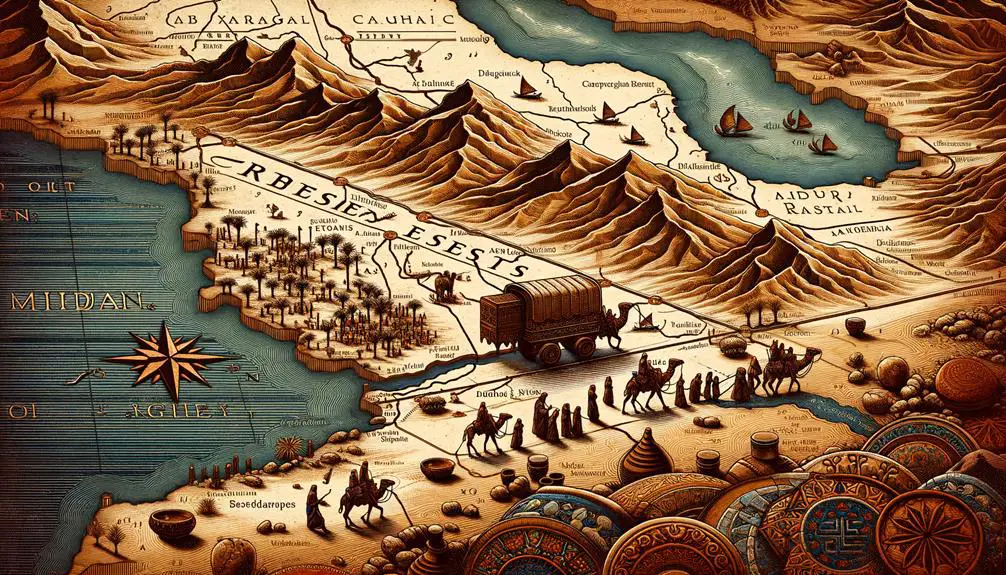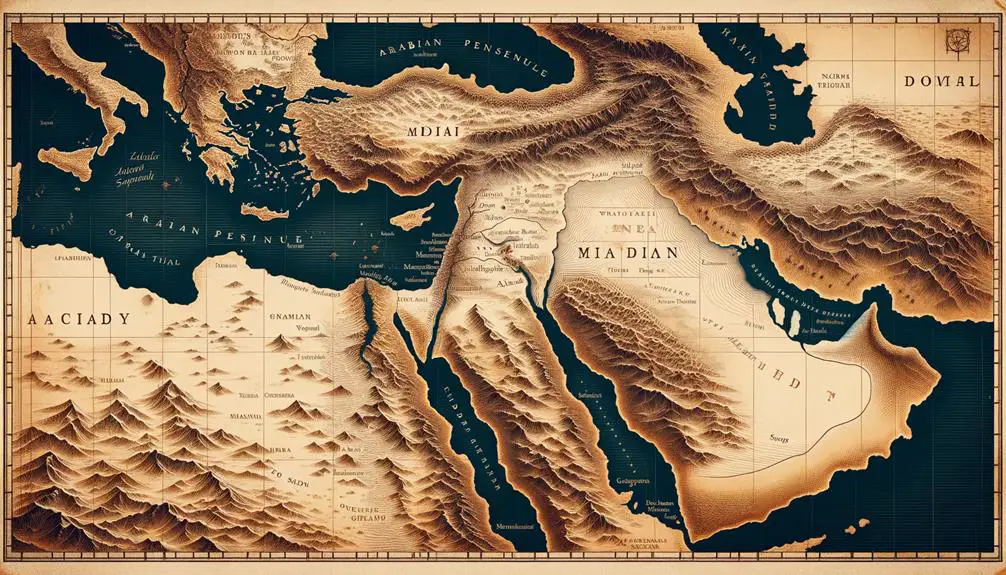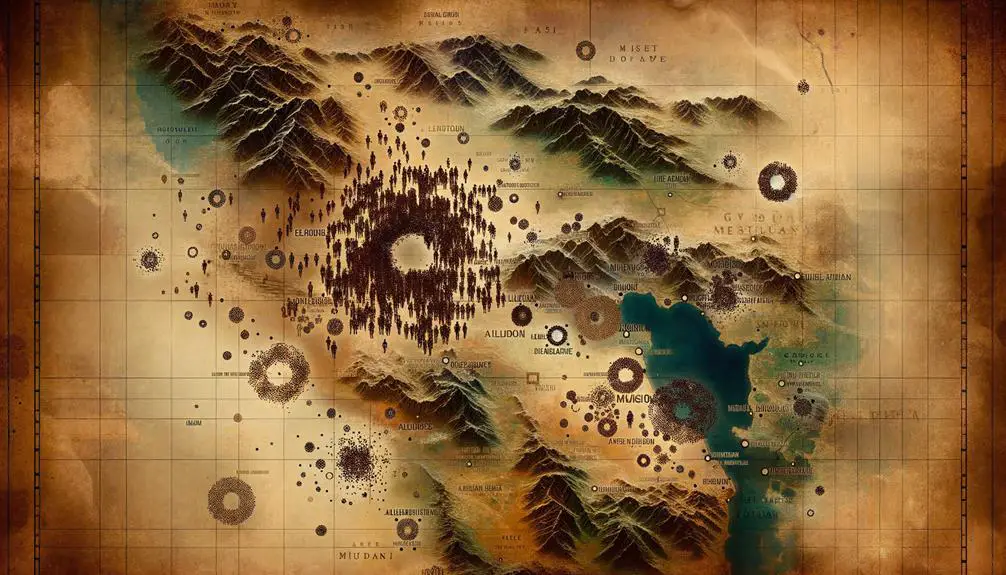Biblical Midian holds a mysterious allure, revealing layers of history and theology that entice the curious to delve deeper.

Where Is Midian in the Bible
You might think that pinpointing Midian in the Bible is a straightforward task, but it's actually wrapped in layers of historical, geographical, and theological complexity. As you explore the biblical references, you'll uncover Midian's significant role in Moses' life and its intricate relationships with neighboring nations.
The geographical location of Midian, straddling the edges of ancient empires, adds another layer of intrigue. Understanding Midian's place in biblical narratives not only sheds light on past conflicts and alliances but also enriches the context for pivotal biblical events.
This journey into Midian's story promises to enhance your appreciation of its role in shaping biblical history.
Key Takeaways
- Midian, often linked to the northwest Arabian Peninsula, plays a crucial role in biblical narratives.
- It served as a refuge for Moses and a site for his spiritual evolution.
- The region's prosperity from trade made it a significant location in stories of conflict and alliance in the Bible.
- Midian's cultural and religious exchanges are highlighted through its interactions with Israel and its influence on biblical figures.
Historical Context of Midian

The historical context of Midian, a significant yet enigmatic region mentioned throughout the Bible, reveals its pivotal role in ancient Near Eastern geopolitics and its complex interactions with neighboring cultures. You'll find that Midian's strategic location along vital trade routes significantly influenced its economy and political relationships. These routes, traversing harsh deserts and connecting ancient civilizations, were arteries of commerce and communication. Midianites, adept at navigating these landscapes, became indispensable intermediaries in the trade networks that linked Egypt with the Arabian Peninsula and beyond.
Delving deeper, you'll discover that Midian's economy thrived on the trade of incense, spices, textiles, and minerals. These commodities were highly sought after in the opulent courts of Egypt, Mesopotamia, and the Levant. The Midianites' mastery over caravan trade turned their region into a bustling hub of economic activity and cultural exchange. This economic prowess didn't only elevate Midian's status among its neighbors but also made it a target of intrigue and, at times, conflict.
Analyzing Midian's role within the broader geopolitical landscape, it's evident that its prosperity was closely tied to its control over trade routes. This control allowed Midian to negotiate alliances, exert influence, and navigate the complex web of relations between empires. The region's economic success was a double-edged sword, attracting both partners and adversaries.
Biblical References to Midian
Having explored Midian's geopolitical significance and economic might, you'll now find that its presence in biblical narratives offers a rich layer of cultural and religious insights that further illuminate its historical role. The biblical references to Midian not only highlight its interactions with Israel but also shed light on Midianite society, including their tribal customs and artifacts such as Midianite pottery.
The narratives involving Midian in the Bible are varied, depicting them sometimes as foes, other times as allies or neutral parties. Here's a concise table to create imagery in your mind regarding their biblical appearances:
Reference |
Context |
Significance |
|---|---|---|
Genesis 37 |
Joseph sold to Midianites |
Marks the Midianites' role in Israel's foundational history |
Exodus 2-4 |
Moses flees to Midian |
Illustrates Midian as a place of refuge and transformation |
Numbers 22-25 |
Midianite involvement in Balaam's story |
Reflects complex relations between Israel and Midian |
Judges 6-8 |
Gideon's battle against Midian |
Showcases Midian's military might and the threat it posed to Israel |
1 Kings 11 |
Solomon's Midianite wives |
Highlights cultural and religious exchanges |
This table points out key moments where Midian intersects with biblical history, revealing a multifaceted relationship with Israel. It's important to note how these references also indirectly inform us about Midianite pottery and tribal customs, as these aspects are interwoven with the narrative contexts. For example, the story of Gideon provides insights into the military strategies and social structures of the Midianites, while the account of Moses' time in Midian offers glimpses into their domestic life and religious practices.
Geographical Location

You must consider that Midian's geographical location, as described in biblical references, intersects with territories of modern nations, complicating its exact placement. This ambiguity influences the scholarly interpretation of Midianites' cultural impact, intertwining history with biblical narratives.
Analyzing these aspects requires a nuanced understanding of ancient and contemporary geopolitical landscapes.
Midian's Biblical References
Midian, as referenced in the Bible, occupies a geographical landscape that scholars have debated, pinpointing its location primarily to the northwest Arabian Peninsula. This region's significance is underscored by:
- Midianite Trade: The Midianites were known for their extensive trade networks, which facilitated the exchange of goods and ideas across vast deserts, linking ancient civilizations.
- Genealogical Origins: The biblical narrative traces the Midianites back to Abraham, highlighting their integral role in the ancestral lineage and the broader historical context.
- Cultural Interactions: Through trade and genealogical ties, Midian served as a crossroads of cultures, religions, and technologies, influencing and being influenced by the surrounding nations.
This analysis underscores the complexity and significance of Midian's geographical and historical position in biblical times.
Ancient Midian: Modern Nations
To accurately understand Ancient Midian's geographical footprint, it's essential to consider that its lands now fall within the borders of modern-day Saudi Arabia and Jordan. This location was strategically significant, positioned along ancient trade routes that facilitated the exchange of goods, ideas, and cultures between civilizations.
The desert ecology of this region played a crucial role in shaping the lifestyle and economy of the Midianites. Their adaptation to this harsh environment enabled them to thrive and control vital trade networks. The arid landscape, characterized by vast deserts interspersed with oases, dictated the settlement patterns and socio-economic activities of Ancient Midian.
Understanding this geographical context provides insights into the strategic importance of Midian in ancient times, anchored by its unique position and environmental adaptations.
Midianites' Cultural Impact
Situated at the crossroads of ancient civilizations, the Midianites significantly influenced the cultural and religious landscapes of neighboring societies through their strategic geographical location. Their location facilitated various trade practices, which not only enriched their economy but also allowed for the exchange of cultural and religious ideas.
- Trade practices: They acted as intermediaries in the spice trade, connecting the East and the West, thereby integrating diverse cultures.
- Artistic contributions: Midianite craftsmanship, especially in pottery and metalwork, showcased unique styles that influenced surrounding regions.
- Cultural exchanges: Their strategic position facilitated interactions with major civilizations, including the Egyptians and Israelites, leading to a blend of religious and societal norms.
Through these avenues, the Midianites left a lasting impact on the cultural tapestry of the ancient Near East.
Midian's Role in Moses' Life

After fleeing Egypt due to his conflict with Pharaoh, Moses found refuge and a pivotal chapter of his life unfolded in Midian. Here, you'll delve into the significance of Midian in shaping Moses' destiny, particularly focusing on his period of exile and his marriage into Zipporah's heritage.
Moses' exile wasn't merely an escape but a transformative journey. In Midian, he transitioned from a prince of Egypt to a shepherd, a role that humbled him and prepared him for his future leadership. This period of solitude and reflection was crucial for his spiritual and personal growth. Midian serves as a backdrop for this evolution, highlighting its role as a place of refuge and transformation.
Zipporah's heritage introduces a fascinating layer to Moses' story. As the daughter of Jethro, a priest of Midian, she bridges Moses' connection to Midianite culture and religion. The marriage symbolizes a pivotal alliance and integration into the community, providing Moses with a new familial and social identity. This union is instrumental in Moses' life, offering him stability and support as he navigates his newfound role in Midian.
Analyzing Moses' exile and Zipporah's heritage reveals Midian's profound impact on his life. This chapter not only sheltered him during a time of vulnerability but also equipped him with the experiences and alliances necessary for his eventual return to Egypt. Through this lens, Midian emerges not just as a geographical location but as a cornerstone in the narrative of redemption and leadership that defines Moses' legacy.
Religious Significance
Exploring the religious significance of Midian reveals its pivotal role in the spiritual journey and leadership development of Moses within the biblical narrative. This region, often overlooked, served as a crucible for Moses, where he encountered God and received his life-changing mission. But beyond this singular event, Midian's complex religious landscape, characterized by its spiritual practices and Midianite deities, played a significant part in shaping the theological context of the time.
Here are three key aspects of Midian's religious significance:
- Midianite Deities and Monotheism: Midian is thought to have been polytheistic, worshiping a pantheon of gods, which contrasted sharply with the monotheism that Moses would later champion. This religious diversity likely provided Moses with a broader understanding of the spiritual beliefs existing outside of the Israelite context, sharpening his monotheistic conviction.
- Spiritual Practices: The Midianites' spiritual practices, though not detailed extensively in the biblical text, would have included rituals and ceremonies that Moses was exposed to during his time in Midian. Such exposure could have influenced his later implementations of ritual worship among the Israelites, including the establishment of the Tabernacle.
- The Priest of Midian: Jethro, the priest of Midian and Moses' father-in-law, plays a significant role in advising Moses on leadership and the organization of the people. This relationship underscores the influence of Midianite religious thought on Moses, blending familial and intercultural spiritual insights that would shape his leadership and religious reforms.
Conflicts and Alliances

In your examination of Midian in the biblical narrative, you'll find that the dynamics of conflict and alliance between the Midianites and Israelites are pivotal.
You'll uncover that tensions often escalated into significant events, shaping the historical and theological landscape of the region.
Analyzing notable alliances will also reveal the complexity of these interactions, highlighting how diplomacy and conflict coexisted in ancient times.
Midianite-Israelite Tensions
Throughout history, the Midianites and Israelites experienced a complex relationship marked by periods of both conflict and alliance. This tension wasn't just political but deeply rooted in their societal interactions, including trade relations and marriage customs.
Here's a breakdown:
- Trade Relations: Economic exchanges often bridged these communities, yet competition over trade routes could lead to friction.
- Marriage Customs: Inter-marriages sometimes served as diplomatic tools, but they could also sow seeds of discord due to differing religious practices.
- Cultural and Religious Differences: These differences fueled misunderstandings and conflicts, despite the occasional alliances formed for mutual benefits.
Analyzing these elements, it's clear that the Midianite-Israelite tensions were multifaceted, influenced by a blend of economic, social, and religious factors.
Notable Midianite Alliances
Despite periods of intense conflict, the Midianites and Israelites also formed notable alliances, reflecting a complex interplay of strategic interests and survival tactics. These alliances often revolved around controlling trade routes and implementing economic strategies that benefited both parties.
Alliance Purpose |
Trade Route Involved |
Economic Strategy |
|---|---|---|
Secure trade access |
Via Maris |
Joint protection fees |
Mutual defense |
King's Highway |
Shared military resources |
Economic cooperation |
Desert pathways |
Trade agreement enforcement |
Diplomatic relations |
Negev trading posts |
Bilateral trade treaties |
These strategic alliances allowed both the Midianites and Israelites to prosper in a region where survival often depended on savvy navigation of both the physical and political landscapes, leveraging trade routes and economic strategies to their mutual benefit.
Key Conflict Events
The complex tapestry of Midianite-Israelite relations is marked by key conflict events that both strained and strengthened their alliances, shaping the geopolitical dynamics of the ancient Near East.
- Control Over Trade Routes: The strategic location of Midian along vital trade routes led to inevitable clashes with Israel, as both sought control over these economic lifelines. This competition underscored many of their conflicts.
- Nomadic Lifestyle: Midian's nomadic lifestyle contributed to unpredictable interactions with Israel. Their movements often encroached on Israelite territories, sparking disputes but also facilitating periods of cooperation and cultural exchange.
- Alliances and Betrayals: Shifts in power dynamics often resulted in alliances being formed and then broken, reflecting the fluid nature of political relations in the region. These events were pivotal in shaping the narrative of both peoples within the biblical context.
Archaeological Evidence

Exploring the archaeological evidence sheds light on the elusive location of Midian, revealing a complex interplay of historical and geographical elements. You delve into the world of pottery analysis and inscription interpretation, two pivotal methods that archaeologists use to decipher the whispers of the past. Pottery analysis, in this context, involves examining shards found in various locations, comparing their styles, compositions, and manufacturing techniques with known Midianite artifacts. This meticulous process helps to map out the probable boundaries of Midian, suggesting a civilization rich in trade and cultural exchange.
Inscription interpretation further enriches your understanding. Ancient texts, etched in stone or scrawled on papyrus, offer direct insights into the lives and movements of the Midianites. These inscriptions, often found in locations far removed from each other, indicate a people adept at navigating the complex social and political landscapes of their time. Through careful analysis, you uncover references to places, events, and figures associated with Midian, piecing together a narrative that spans centuries.
These archaeological endeavors reveal a society that was both influential and interconnected, challenging previous assumptions about its size and scope. The evidence suggests that Midian wasn't just a footnote in ancient history but a significant player in the regional dynamics of the time. As you sift through the layers of the past, you're reminded of the enduring power of archaeology to uncover the stories of those long gone, bringing clarity to our understanding of ancient texts and the world they describe.
Frequently Asked Questions
How Has the Perception of Midian and Its People Changed in Modern Religious Studies and Scholarship?
In modern religious studies, your understanding of Midian and its inhabitants has evolved significantly. Scholarly debates and the discovery of Midianite artifacts have fueled a reevaluation. Previously, views were largely shaped by biblical narratives, but now, there's a push towards a more nuanced interpretation.
You're seeing a shift from viewing Midianites as mere biblical antagonists to recognizing their complex societal structures and cultural contributions. This change reflects broader trends in scholarship, favoring evidence-based over purely textual analyses.
Are There Any Contemporary Cultures or Communities That Claim Descent From the Midianites?
Yes, certain contemporary cultures and communities indeed assert their descent from the Midianites. Genetic research and archaeological findings have begun to shed light on these claims, offering a fascinating glimpse into the historical connections.
While the evidence is still unfolding, it's clear that the legacy of the Midianites continues to influence modern identities. This intersection of history and genetics offers a unique perspective on how ancient narratives shape contemporary self-understanding.
How Do Fictional and Artistic Portrayals of Midian Differ From Its Historical and Biblical Descriptions?
In fictional and artistic portrayals, creators often take artistic license, veering from historical and biblical descriptions of Midian. They might inject mythological parallels or dramatize characteristics to enhance storytelling. This creative freedom allows for a broader interpretation, sometimes deviating significantly from traditional narratives.
Through this lens, Midian transforms, reflecting the artists' visions rather than sticking strictly to its original depiction, offering a rich tapestry of interpretation and reimagination.
What Are the Environmental and Climatic Conditions of the Region Historically Associated With Midian, and How Might They Have Influenced the Lifestyle and Economy of Its Inhabitants?
You're delving into the diverse dynamics of desert dwellings.
The environmental and climatic conditions of the region historically linked with Midian significantly shaped its inhabitants' lifestyle and economy.
Arid areas and scarce water sources necessitated innovative agricultural practices, focusing on irrigation and crops that could withstand harsh conditions.
This lifestyle not only dictated daily activities but also influenced the broader economic structures, from trade routes to social hierarchies.
Has the Story of Midian and Its Interactions With Ancient Israel Influenced Modern Geopolitical or Interfaith Dialogues?
You're examining how ancient narratives shape today's discussions, particularly focusing on trade relationships and military strategies.
The story of Midian and its dealings with ancient Israel has subtly influenced modern geopolitical and interfaith dialogues.
By understanding these historical interactions, you can grasp how past trade and military tactics inform current policies and relationships.
This analysis offers a nuanced view, shedding light on the complexities of contemporary discussions influenced by ancient precedents.
Conclusion
You might argue that Midian's precise location remains a topic of debate among scholars, yet the evidence points towards its significant historical and religious standing. Through biblical references, it's clear Midian played a pivotal role in Moses' life and the broader narrative of the Israelites.
Archaeological finds further underscore Midian's tangible presence in history. Thus, despite uncertainties about its exact geography, Midian's impact on religious traditions and historical accounts is undeniably profound and well-documented.



Sign up